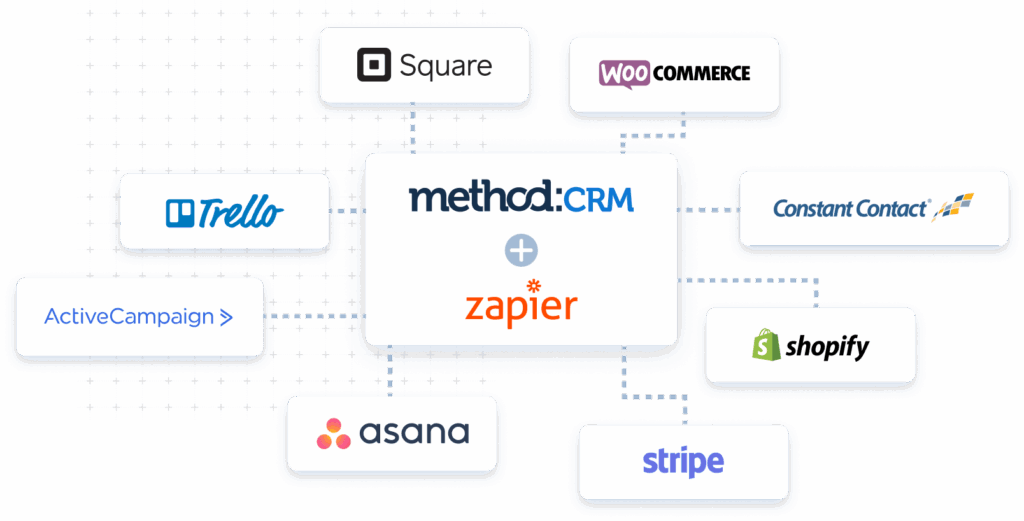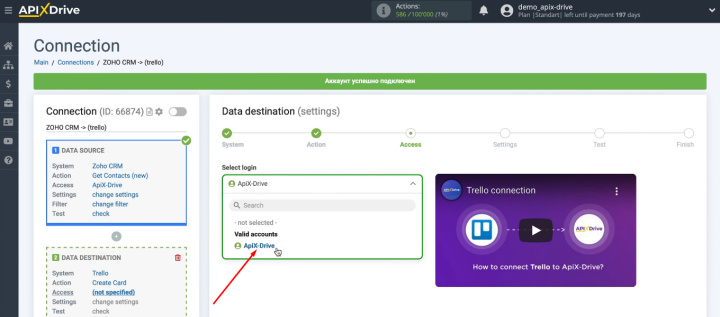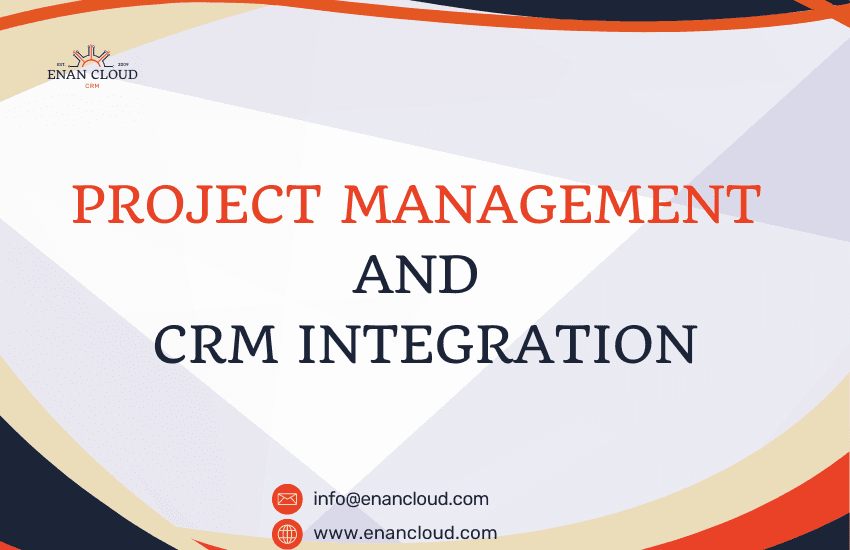
Supercharge Your CRM: Seamless Integration with Zapier for Maximum Efficiency
In today’s fast-paced business environment, staying ahead of the curve requires more than just hard work; it demands smart work. One of the most crucial aspects of smart work is leveraging the right tools and integrating them seamlessly. This is where the dynamic duo of Customer Relationship Management (CRM) systems and Zapier comes into play. This comprehensive guide will delve into the power of CRM integration with Zapier, exploring its benefits, how to set it up, and examples of how it can revolutionize your business processes. We’ll explore the intricacies of how Zapier can connect your CRM with hundreds of other apps, automating workflows and boosting productivity to levels you never thought possible.
Understanding the Power of CRM and Zapier
Before diving into the integration, let’s establish a solid understanding of each component.
What is a CRM?
A CRM, or Customer Relationship Management system, is a software solution designed to manage and analyze customer interactions and data throughout the customer lifecycle. Think of it as the central nervous system of your sales, marketing, and customer service operations. Key functions of a CRM include:
- Contact Management: Storing and organizing customer information, including contact details, communication history, and purchase data.
- Lead Management: Tracking and nurturing leads through the sales funnel.
- Sales Automation: Automating repetitive sales tasks, such as email follow-ups and proposal generation.
- Marketing Automation: Automating marketing campaigns, such as email marketing and social media posting.
- Customer Service: Managing customer inquiries, resolving issues, and providing support.
- Reporting and Analytics: Providing insights into customer behavior, sales performance, and marketing effectiveness.
Popular CRM systems include Salesforce, HubSpot, Zoho CRM, Pipedrive, and many more. Choosing the right CRM depends on your business size, industry, and specific needs. A well-implemented CRM can significantly improve customer satisfaction, increase sales, and streamline business operations.
What is Zapier?
Zapier is an online automation tool that connects different web applications, allowing you to automate workflows between them. It works by creating “Zaps,” which are automated tasks that run when a specific trigger occurs. Think of it as the glue that holds your digital ecosystem together. Zapier’s key features include:
- Connects Hundreds of Apps: Zapier integrates with thousands of popular apps, including CRM systems, email marketing platforms, social media platforms, project management tools, and more.
- Automated Workflows: Zaps automate repetitive tasks, saving you time and effort.
- Trigger-Action Logic: Zaps are based on a trigger-action model. When a trigger event occurs in one app, Zapier automatically performs an action in another app.
- No Coding Required: Zapier’s user-friendly interface allows you to create Zaps without any coding knowledge.
- Customization Options: You can customize Zaps to fit your specific needs, including filtering data, adding delays, and more.
Zapier simplifies the process of connecting your favorite apps, allowing you to automate tasks and focus on what matters most – growing your business.
The Benefits of CRM Integration with Zapier
Integrating your CRM with Zapier unlocks a world of possibilities, streamlining your workflows and boosting your overall efficiency. Here are some key benefits:
1. Automation of Data Entry
One of the most significant time-wasters in any business is manual data entry. Imagine having to manually transfer data from a lead generation form on your website to your CRM, or from a spreadsheet to your CRM. Zapier eliminates this tedious task by automatically transferring data between your CRM and other apps. When a new lead fills out a form, Zapier can automatically create a new contact in your CRM, saving you valuable time and reducing the risk of human error.
2. Improved Lead Management
Zapier can automate lead nurturing processes, ensuring that leads are engaged and followed up with promptly. For example, when a new lead is created in your CRM, Zapier can automatically send a welcome email, add the lead to a marketing campaign, or assign the lead to a sales representative. This ensures that no lead falls through the cracks and that leads are nurtured effectively throughout the sales funnel.
3. Enhanced Sales Efficiency
By automating sales tasks, Zapier empowers your sales team to focus on closing deals. For example, when a deal is closed in your CRM, Zapier can automatically create a project in your project management software, send a welcome email to the new customer, or update a spreadsheet with the deal details. This reduces the administrative burden on your sales team, allowing them to dedicate more time to selling.
4. Streamlined Marketing Campaigns
Zapier can automate various marketing tasks, such as adding new leads to email marketing lists, segmenting leads based on their behavior, and tracking campaign performance. For example, when a lead clicks on a specific link in an email, Zapier can automatically update their lead score in your CRM. This allows you to personalize your marketing campaigns and target your audience more effectively.
5. Improved Customer Service
Zapier can automate customer service tasks, such as creating support tickets in your help desk software when a customer submits a support request, sending automated responses to customer inquiries, and updating customer information in your CRM when a support ticket is resolved. This improves customer satisfaction and reduces the workload on your customer service team.
6. Increased Productivity
By automating repetitive tasks and streamlining workflows, Zapier frees up your team’s time, allowing them to focus on more strategic initiatives. This leads to increased productivity and a more efficient use of resources.
7. Better Data Accuracy
Automating data transfer reduces the risk of human error, ensuring that your data is accurate and up-to-date. This leads to better decision-making and more effective business strategies.
How to Integrate Your CRM with Zapier: A Step-by-Step Guide
Integrating your CRM with Zapier is a straightforward process. Here’s a step-by-step guide to get you started:
Step 1: Choose Your CRM and Zapier Account
First, ensure you have a CRM system and a Zapier account. If you don’t have a CRM, choose one that suits your business needs. Select a Zapier plan that aligns with your usage requirements.
Step 2: Connect Your CRM to Zapier
Log in to your Zapier account and connect your CRM. Zapier supports a wide range of CRM systems, so search for your CRM in the app directory. You’ll typically need to authorize Zapier to access your CRM account. This usually involves entering your CRM login credentials and granting Zapier the necessary permissions.
Step 3: Choose a Trigger and Action
Decide on the workflow you want to automate. This involves choosing a trigger and an action. The trigger is the event that starts the Zap, while the action is what Zapier does in response to the trigger.
For example, if you want to create a new contact in your CRM when a new lead submits a form on your website, the trigger would be “New Form Submission” in your form builder app (e.g., Typeform, Google Forms), and the action would be “Create Contact” in your CRM (e.g., HubSpot, Salesforce).
Step 4: Configure Your Zap
Configure your Zap by mapping the data fields from the trigger app to the corresponding fields in your CRM. For example, you’ll map the “Name” field from your form builder to the “Name” field in your CRM. You may also add filters, delays, or other customizations to your Zap to tailor it to your specific needs.
Step 5: Test Your Zap
Before activating your Zap, test it to ensure it’s working correctly. Zapier will allow you to send a test data sample through the Zap to see if the action is performed as expected. Review the results and make any necessary adjustments.
Step 6: Turn on Your Zap
Once you’re satisfied with the results of your test, turn on your Zap. Zapier will now automatically run the Zap whenever the trigger event occurs.
Step 7: Monitor and Optimize
Monitor your Zaps to ensure they’re running smoothly. You can track the number of tasks completed and identify any errors. Review your Zaps periodically and optimize them as needed to improve efficiency and accuracy.
Examples of CRM Integration with Zapier in Action
Let’s explore some real-world examples of how CRM integration with Zapier can transform your business processes:
1. Lead Capture and Qualification
Scenario: You’re using a lead generation form on your website to collect leads. When a new lead submits the form, you want to automatically create a new contact in your CRM, tag the lead based on their responses, and send them a personalized welcome email.
Zap:
- Trigger: New Form Submission (e.g., Typeform, Google Forms)
- Action: Create Contact in CRM (e.g., HubSpot, Salesforce), Add Tag, Send Email (e.g., Gmail, Mailchimp)
2. Sales Pipeline Automation
Scenario: When a deal is marked as “Won” in your CRM, you want to automatically create a project in your project management software, notify the relevant team members, and send a welcome email to the new customer.
Zap:
- Trigger: Deal Won in CRM (e.g., Pipedrive, Zoho CRM)
- Action: Create Project in Project Management Software (e.g., Asana, Trello), Send Notification (e.g., Slack, Microsoft Teams), Send Email (e.g., Gmail, Outlook)
3. Customer Support Automation
Scenario: When a customer submits a support request via email, you want to automatically create a support ticket in your help desk software, add the customer’s contact information to your CRM, and send an automated acknowledgment email.
Zap:
- Trigger: New Email in Email Provider (e.g., Gmail, Outlook)
- Action: Create Ticket in Help Desk Software (e.g., Zendesk, Freshdesk), Create Contact in CRM (e.g., HubSpot, Salesforce), Send Email (e.g., Gmail, Outlook)
4. Event Management Automation
Scenario: You’re hosting a webinar. When a new attendee registers for the webinar, you want to automatically add them to your CRM, send them a confirmation email, and add them to your webinar platform.
Zap:
- Trigger: New Registration in Webinar Platform (e.g., Zoom, GoToWebinar)
- Action: Create Contact in CRM (e.g., HubSpot, Salesforce), Send Email (e.g., Gmail, Outlook), Add to Webinar Platform
5. E-commerce Automation
Scenario: When a customer makes a purchase on your e-commerce platform, you want to automatically create a new contact in your CRM, add the purchase details to the contact record, and send a thank-you email.
Zap:
- Trigger: New Purchase in E-commerce Platform (e.g., Shopify, WooCommerce)
- Action: Create Contact in CRM (e.g., HubSpot, Salesforce), Update Contact with Purchase Details, Send Email (e.g., Gmail, Outlook)
Advanced CRM Integration Strategies with Zapier
Once you’ve mastered the basics, you can explore more advanced integration strategies to maximize the power of your CRM and Zapier setup:
1. Data Enrichment
Use Zapier to enrich your CRM data with information from other apps. For instance, you can connect your CRM to a data enrichment service like Clearbit to automatically add company information, social media profiles, and other valuable data to your contact records. This provides your sales and marketing teams with a more complete view of your customers, enabling them to personalize their interactions more effectively.
2. Two-Way Syncing
Set up two-way syncing between your CRM and other apps to ensure that data is always up-to-date in both systems. For example, you can sync contact updates between your CRM and your email marketing platform. This ensures that changes made in one system are automatically reflected in the other, reducing the risk of data inconsistencies.
3. Conditional Logic and Branching
Utilize Zapier’s conditional logic and branching features to create more complex workflows. For instance, you can use filters to route leads to different sales representatives based on their location or industry. This allows you to tailor your workflows to specific scenarios and optimize your processes for maximum efficiency.
4. Scheduled Zaps
Schedule Zaps to run at specific times or intervals. This is particularly useful for tasks like generating reports, sending automated emails, or updating data on a regular basis. For example, you can schedule a Zap to automatically generate a weekly sales report and send it to your sales team.
5. Integration with Custom Apps
If you use custom apps that aren’t directly supported by Zapier, you can use webhooks to integrate them with your CRM. Webhooks allow you to trigger Zaps from external applications by sending data to a specific URL. This opens up a whole new world of integration possibilities.
Troubleshooting Common CRM and Zapier Integration Issues
While CRM integration with Zapier is generally straightforward, you may encounter some issues along the way. Here are some tips for troubleshooting common problems:
1. Connection Issues
Make sure that your CRM and Zapier accounts are properly connected. Double-check your login credentials and ensure that you’ve granted Zapier the necessary permissions. Sometimes, disconnecting and reconnecting your accounts can resolve connection issues.
2. Data Mapping Errors
Carefully review your data mapping to ensure that data fields are correctly mapped between your CRM and other apps. Incorrect data mapping can lead to data being entered incorrectly or not at all. Test your Zaps thoroughly to identify and correct any mapping errors.
3. Trigger and Action Errors
If your Zap isn’t triggering or the action isn’t being performed, check your trigger and action settings. Make sure that the trigger event is occurring and that the action is set up correctly. Review the Zap’s history to identify any error messages and troubleshoot accordingly.
4. Rate Limits
Be aware of rate limits imposed by your CRM and other apps. Rate limits restrict the number of API calls you can make within a certain time period. If you exceed these limits, your Zaps may be temporarily paused. Optimize your Zaps to minimize the number of API calls and consider upgrading your Zapier plan to increase your rate limits.
5. Data Formatting Issues
Ensure that your data is formatted correctly for your CRM and other apps. For example, dates must be in the correct format. Use Zapier’s formatting tools to convert data to the required format.
6. Contacting Support
If you’re still experiencing issues, don’t hesitate to contact Zapier’s support team or your CRM provider’s support team. They can provide assistance with troubleshooting and resolving complex integration problems.
Choosing the Right CRM and Zapier Plan for Your Business
The success of your CRM and Zapier integration depends on choosing the right tools and plans for your business. Here’s what to consider:
1. CRM Selection
When selecting a CRM, consider the following factors:
- Features: Does the CRM offer the features you need, such as contact management, lead management, sales automation, and marketing automation?
- Scalability: Can the CRM scale to accommodate your business growth?
- Integrations: Does the CRM integrate with the other apps you use?
- Ease of Use: Is the CRM user-friendly and easy to learn?
- Pricing: Does the CRM fit within your budget?
2. Zapier Plan Selection
Choose a Zapier plan that aligns with your usage requirements:
- Number of Tasks: Consider how many tasks you need to automate each month.
- Number of Zaps: Determine how many Zaps you need to create.
- App Integrations: Ensure that the plan supports the apps you want to integrate.
- Premium Features: Consider whether you need premium features like multi-step Zaps, filters, or custom logic.
3. Budget
Factor in the cost of both the CRM and Zapier when budgeting for your integration. The cost of these tools can vary depending on the features and plans you choose. Weigh the cost against the potential benefits, such as increased productivity, improved efficiency, and higher sales.
The Future of CRM and Zapier Integration
The integration of CRM systems with automation tools like Zapier is constantly evolving. Here’s what the future holds:
1. Artificial Intelligence (AI) and Machine Learning (ML)
AI and ML will play an increasingly important role in CRM and Zapier integrations. Expect to see more AI-powered features, such as automated lead scoring, predictive analytics, and personalized marketing recommendations. ML algorithms will be used to optimize workflows and improve the accuracy of data. The integration will become even smarter and more proactive, anticipating your needs and automating tasks before you even realize you need them.
2. Enhanced Integration Capabilities
Expect to see more seamless integrations between CRM systems and other apps. This includes deeper integrations with industry-specific applications and more support for emerging technologies. The goal is to create a truly unified digital ecosystem where data flows seamlessly between all your tools.
3. Increased Automation
Automation will continue to expand, covering more aspects of your business. Expect to see more complex workflows, such as automated customer onboarding, automated customer service, and automated reporting. The aim is to automate as many repetitive tasks as possible, freeing up your team to focus on more strategic initiatives.
4. User-Friendly Interfaces
The user interfaces of CRM systems and Zapier will become even more user-friendly and intuitive. Expect to see more drag-and-drop functionality, pre-built templates, and guided workflows. This will make it easier for businesses of all sizes to set up and manage their integrations.
5. Focus on Data Privacy and Security
Data privacy and security will become even more important. Expect to see more robust security features and compliance with data privacy regulations, such as GDPR and CCPA. The goal is to ensure that your data is protected and that your integrations comply with all relevant regulations.
Conclusion: Embrace the Power of Integration
Integrating your CRM with Zapier is no longer a luxury; it’s a necessity for businesses that want to thrive in today’s competitive landscape. By automating workflows, streamlining processes, and improving data accuracy, you can unlock the full potential of your CRM and boost your overall efficiency.
This guide has provided you with a comprehensive overview of CRM integration with Zapier, covering the benefits, setup process, and real-world examples. By following the steps outlined in this guide, you can transform your business processes, increase productivity, and drive growth.
So, take the plunge, embrace the power of integration, and watch your business soar!

